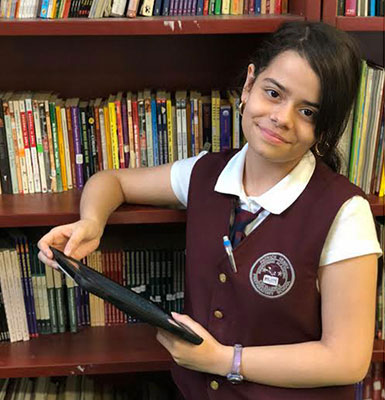Crossing the digital divide and finding success: one student’s story

Evelyn, P.S. 171 Patrick Henry Middle School student who was accepted into the prestigious Manhattan Hunter Science High School.
Chris Reasor, a teacher at Patrick Henry explained, “Since Verizon Innovative Learning came in, we have seen the school environment change in a lot of ways. More student-centered learning. Teachers do less lecturing, shifting more towards students exploring and creating things. A more discovery-type approach.”
Since getting her iPad, Evelyn’s interest in biology has blossomed and she has been able to research different aspects of neurology. She also was given a way to research her different high school prospects.
Evelyn’s peers are using the new devices to explore their interests and to write their application essays to prestigious STEM-related high schools like the Academy for Software Engineering, Brooklyn Technical School, the Urban Assembly Gateway School for Technology, the Manhattan Center for Science & Mathematics and Young Women’s Leadership.
All of these schools have accepted students from Patrick Henry for the next school year.
It is success stories like P.S. 171 Patrick Henry in Harlem that led to Verizon’s expansion of the Verizon Innovative Learning initiative. Today, Verizon announces a more than $200 million in additional funds towards Verizon Innovative Learning. With its new total investment of more than $400 million, the company announced its goal of reaching an additional five million students over the next five years and has committed to doublling the number of in-school programs it supports from 100 middle schools, beginning in September 2018, to 200 middle schools by the end of 2020.
Verizon has become increasingly concerned about the chasm between those Americans who are prepared to thrive in the digital age and those who are not.
Lowell McAdam, Chairman and CEO of Verizon.
You too can help students like Evelyn.
For students like Evelyn, that chasm has already started to close. With this investment, millions of students will begin to bridge the digital divide and can prepare to join the workforce of tomorrow that transforms our future society.
Now, through April 15, 2018 Verizon is calling on the public to nominate a local middle school in need for the opportunity to become a Verizon Innovative Learning school. Advocates should quote tweet and/or reply to one of a series of videos posted to the @Verizon Twitter handle, highlighting impactful stories from the program, along with the school name and location, using #Humanability.